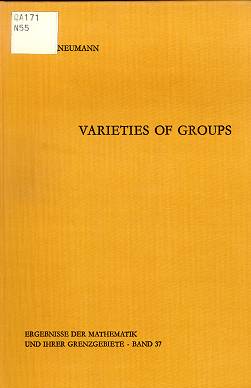Hanna Neumann
Varieties of Groups
Springer-Verlag, 1967

Preface
Varieties of algebras are equationally defined classes of algebras, or "primitive classes" in Mac'cev's terminology. They made their first explicit appearance in the 1930's, in Garrett Birkhoff's paper on "The structure of abstract algebras" and B.H. Neumann's paper "Identical relations in groups I". For quite some time after this, there is little published evidence that the subject remained alive. In fact, however, as part of "universal algebra", it aroused great interest amongst those who had access, directly or indirectly, to Philip Hall's lectures given at Cambridge late in the 1940's. More recently, category theory has provided a general setting since varieties, suitably interpreted, are very special examples of categories. Whether their relevance to category theory goes beyond this, I do not know. And I doubt that the category theoretical approach to varieties will be more than a fringe benefit to group theory. Whether or not my doubts have substance, the present volume owes its existence not to the fact that varieties fit into a vastly more general pattern, but to the benefit group theory has derived from the classification of groups by varietal properties. It is this aspect of the study of varieties that seems to have caused its reappearance in the literature in the 1950's. Since then varietal methods in group theory have rapidly gained impetus and, as is wont to happen, they have thrown up their own problems and developed into a branch of group theory which is as much of intrinsic interest as it is powerful as a tool.
A course of lectures given in 1963 at the Manchester College of Science and Technology started the process of gathering and sorting the results on varieties of groups. Perhaps this very process has had some share in accelerating progress. In any event, when, after too long a time, the manuscript was ready for the publishers, it was also ready to be re-written. Experience shows that a report of this kind, delayed too long, becomes useless (if, indeed, it appears at all!). I therefore decided against re-writing which would have meant a long delay. It may then be in order to indicate briefly in this preface two of the points that I would have wanted to attend to.
The first is mainly, though not entirely, a matter of organization of material. Knowledge of metabelian varieties was scant until quite recently when it expanded so rapidly that, to do it justice, a separate chapter should now have been given to this topic. Instead I have merely added to the information provided in various contexts — a plan that was natural and adequate a short time ago. I have tried to ensure that these scattered references to the metabelian case are easily located by means of the index.
Secondly, I want to draw attention to an alternative development which has great advantages. Smel'kin's embedding theorem should, I believe, be made the starting point of the treatment of product varieties. Its proof is direct, needing no more than basic facts and the construction of the verbal wreath product; but its use would shorten and simplify much of Chapter 2 and several other topics besides (for example in Chapter 4.)
Contents
Chapter 1. The Basic Facts- Preliminaries
- Words, Laws, Verbal Subgroups
- Relatively Free Groups
- Varieties
- Varieties as Closed Classes of Groups
- The n-Generator Groups and the n-Variable Laws of a Variety
- Discrimination and Residual Properties
- Verbal Products
- The Algebra of Varieties
- Wreath Products and Discrimination
- The Uniqueness of Factorization
- Some Classes of Indecomposable Varieties
- Product Varieties Generated by a Finitely Generated Group
- Residual Properties of the Free Groups of Product Varieties
- Summary of Properties of Nilpotent Groups
- Residual Properties
- A Lemma on Words with an Application to Free Products
- The Laws of a Nilpotent Variety and Related Topics
- Generating Groups of Finite Rank
- The Variety of All Metabelian Nilpotent Groups of Class c
- Remarks on Automorphisms and the Hopf Property
- Free Subgroups of Free Groups
- Theorems Like Auslander and Lyndon's: the Schreier Property
- The Splitting Property; Direct Decomposability
- Critical Groups and Cross Varieties
- The Theorem of Oates and Powell
- Critical Groups and Subvarieties
- Critical p-Groups and Locally Finite Varieties; a Summary of Developments
